BONAIRE

Bonaire is a small island in the southern Caribbean – just off the northern coast of Venezuela. It is the “B” in the ABC Islands – the others being Aruba and Curacao. Bonaire is the easternmost of the islands.
Bonaire’s history was discussed with that of Aruba and Curacao on our ABC Islands page.
Bonaire continues to develop while maintaining awareness of what makes them special. They established the first nature sanctuary in the Netherland Antilles in 1969 – the STINAPA Bonaire, or Stitching Nationale Parken Bonaire. Their mission is “to protect and manage its natural, cultural and historical resources, while allowing ecologically sustainable use for the benefit of future generations.” This sanctuary has two arms – the Bonaire National Marine Park and the Washington Slaagbaai National Park.
The marine park surrounds the entire island from the high water mark to 200 feet of depth, and they enforce efforts to protect their marine environment. There is no anchoring anywhere around the island. Visiting boats can rent one of 42 moorings off Kralendijk or go in the Harbour Village Marina. There is no spear fishing. All divers and snorkelers pay a fee to support the marine park. The underwater environment suggests that their efforts are succeeding.
Washington Slagbaai National Park is comprised of approximately 14,000 acres (20% of Bonaire’s land) on the northwest part of the island. It is a rugged area that appears inhospitable to life other than cactus and lizards. There is also some scrub brush and a few goats.
Bonaire is a very dry island. It gets 20.5 inches of rain annually, and most of that falls from October through February. Their soil is very dry and blows around with the winds. They import virtually all of their food from Venezuela. Very little grows here.

One of many colorful Carnival participants
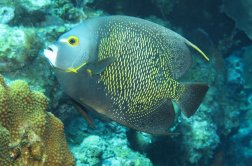
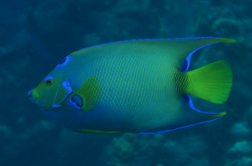
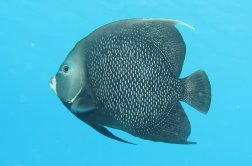
All on one dive – all right under our boat
The reef is nice, but it is not as colorful as some others. However, the fish are plentiful. We saw everything from tiny blennies to 40 pound tarpon. There is an absence of sharks here, and that may appeal to some divers. However, we cannot but wonder why they are not here. We enjoy seeing most sharks while diving. But we were not deprived of underwater critters to look at.
We have two batteries for our old underwater digital camera (we have finally retired our Nikonos film cameras – sadly). Neither battery would hold a charge. We tried to buy new batteries, but we could not find them. So what to do? Buy a new camera!! This was an unplanned expense, but we could not imagine diving here without a camera.
We bought: Canon PowerShot G16 camera, Fantasea FG16 housing, Sea & Sea YS-01 strobe, and a Ultralight arm system
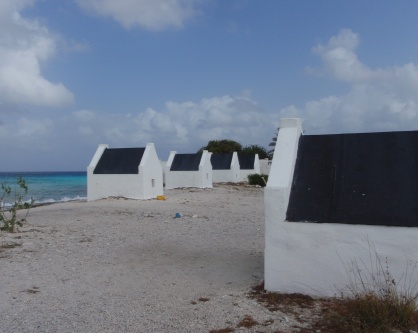
Slave huts near salt pans
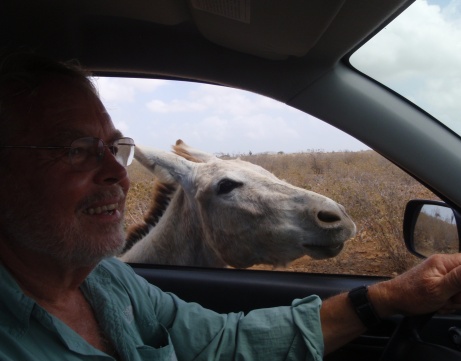
Oh please – just one more carrot then I’ll stop begging
This system is a big step up from a ‘point-and-shoot’ camera, but it is not an SLR. It has its limitations. But it has been great fun to have while here in this aquarium.
One camera for two divers? So far we are sharing every other dive. Time will tell how this influences domestic tranquility.
We also spent some time touring around the island seeing the sights.
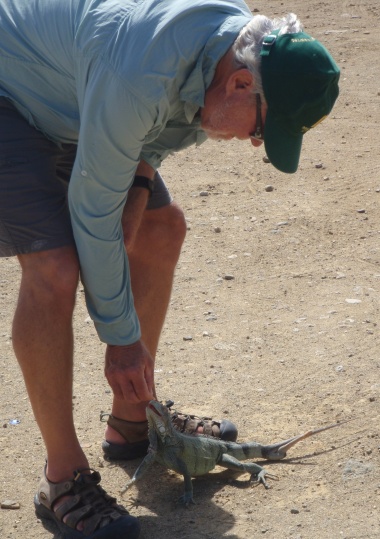
Bud sharing his granola bar with iguana
The park has a one-way dirt road through it, and only trucks or SUV-type vehicles with good clearance are allowed in. Vehicles need lots of clearance to pass over this rugged road, and standard cars are turned away. The road offers two options – the short route which usually takes about 1 ½ hours to drive and the long route that takes about 2 ½ hours. We took the long route.
We followed the trail/road up the northeast coast of the island where the wind was howling and the seas were crashing. It was a spectacular sight. We went around the top of the island where there is an abandoned light house and research station. Then we traveled down the northwest coast where the sea calms enough for dive sites, but we did not have dive gear with us.
We had heard that at one of the dive sites, Playa Funchi, there are iguanas so accustomed to people that they greet you in the parking area. Sure enough. Bud shared his granola bar with one.
And we finally saw some flamingos. We had been a few places where they are known to hang out, but we did not see any until Boka Slagbaai in the park. Pretty.
The park is rugged, but it is also beautiful. We were pleased to see that Bonaire is preserving this area.
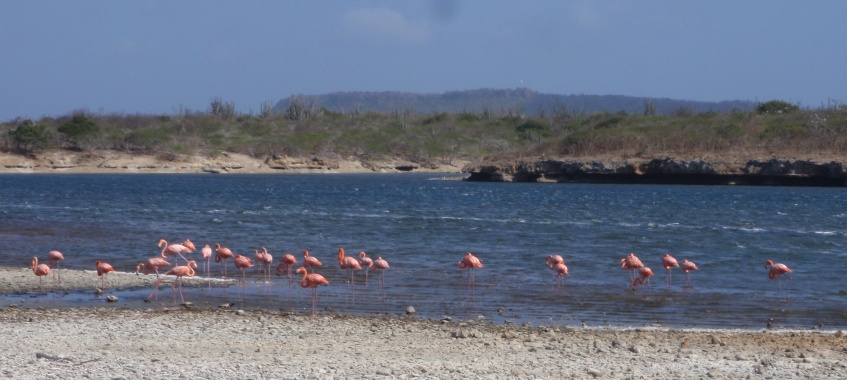
Nothing but cactus and lizards for a few hours, then a flock of flamingos appear
Moving on…
We had planned to spend ten or twelve days in Bonaire. We stayed for almost a month. Part of our delay was because we were enjoying the diving, and we did not want to rush on. Then the winds came up. We had big winds for about ten days that kept us in place. We thought that Bonaire was a great place to wait out a weather delay.
We both grew to like Bonaire a lot. We like the diving and the laid back lifestyle. This has been a very good stop. But now we will move on to Curacao.
Go to our ABC Islands page or the other ABC Islands of Aruba or Curacao
Or return to our Caribbean page